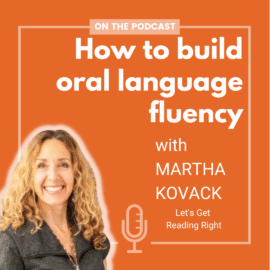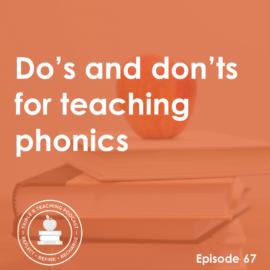
TRT Podcast #133: What is cognitive load, and why does it matter?
Learn what cognitive load has to do with teaching reading, and discover specific things you can do to avoid overwhelming your students’ working memories.
Listen to the episode here
Full episode transcript
Let's talk cognitive load. What's that all about? We hear a lot about it in the science of reading circles, but what is it, why does it matter, and what does it have to do with teaching reading?
John Sweller published his cognitive load theory in 1988, and according to his theory, teachers should be aware of the limits of working memory because if we overwhelm it, our teaching will be less effective.
So what is working memory? Well, there's long-term memory and there's working memory.
Long-term memory holds the information you've learned and stored. It's really interesting to note that there are no limits to long-term memory. There's a lot in there that you can pull out. You know when somebody asks you a question and you say, "Well, hang on. Let me think about it for a minute"? You're working to get it out of your long-term memory.
Working memory is very different. It's a temporary holding place. It's the small amount of information that you can hold in your mind while you're working through a problem. The authors of a book called "Uncommon Sense Teaching" compare working memory to an octopus juggling a set of balls, and the average person can only juggle about four thoughts at a time before the ideas begin to slip.
It makes me think about when I go to the grocery store and have my list of items I'm going to get, and I'm walking into the store and suddenly I remember an extra item. I wanted to get that taco seasoning. Okay, don't forget, taco seasoning, taco seasoning, taco seasoning. Oh, look, there's something on sale that I want to buy. Oh, now I have to decide between these different types of bread rolls for lunch, and then all of a sudden the thought of taco seasoning falls out of my working memory. And often I don't remember it again until I'm walking out of the store with a full cart of groceries headed to my car.
Your students use working memory when they follow a multi-step problem or multi-step directions, when they remember the sounds in a word as they sound it out, or remember what they just read as they make sense of a paragraph.
Just like us, students have limited working memory, and that's why they'll forget what you've asked them to do if you give them too many steps at once. Just like adults, students have different amounts of working memory, so some can hold maybe just three items. Others could maybe hold six or more.
The reason why this is important for teaching reading is there are some things that we teach our students that may be unnecessary, and they may increase cognitive load by filling up their working memory, and then that makes it difficult for them to focus on what really matters.
Some people do not appreciate the very specific step-by-step method that many Orton-Gillingham programs share for dividing words into syllables. There's a lot to keep in mind.
First, you have to find and label the vowels. Then you look between the vowels and you find and label the consonants. Then you remember your syllable division strategies and divide the word appropriately. Then you look at a part of the word and decide what syllable type it is. Some children can do this, some children are successful with this, but for others, it's a lot to keep in their working memory.
So the question is, is this really worth all that effort? Are there different ways that we could teach kids to divide words into syllables that don't require such a strain on the working memory?
I've also heard concerns from people related to teaching all the words connected to a sound wall.
Some teachers might want to teach the words "fricative" or "affricate" or "liquid," all those words that have to do with the types of phonemes, but others will say that's really putting a strain on your students' working memory. That it's increasing their cognitive load, and that's just not necessary.
There are two kinds of cognitive load. There's intrinsic, which refers to the difficulty of the task when compared to the background knowledge of the learner, and then there's extrinsic cognitive load, and that's anything that makes it harder to learn.
Our goal is to decrease that extrinsic cognitive load as much as possible. If we give too many steps at once or we overcomplicate our lessons, then we increase the extrinsic cognitive load and we make it harder for our students to learn.
A really good way to decrease that extrinsic cognitive load is to teach with explicit instruction. Explicit instruction refers to how lessons are designed and how teachers deliver those lessons. It's being very straightforward and leaving nothing to chance. Using routines is a really great part of explicit instruction that can reduce cognitive load because when the students know that every time we do this a certain way, then that routine is something they know, and their working memory can be used to learn the new skill or the new concept.
When you have blending routines, that can decrease extrinsic cognitive load. When you have routines for phoneme grapheme mapping, that can decrease extrinsic cognitive load.
It's also important to note that information in students' long-term memory can help them process new information.
Maybe you've heard of that baseball study by Recht and Leslie. In that study, they had a group of middle schoolers read an article about a baseball game. After reading it, they had them each reenact the baseball game using figures and talking about what happened. The kids who were strong readers but had a weak understanding of baseball did not do as well as the kids who would typically not be classified as strong readers, but did understand baseball.
You see, the kids who had this understanding of baseball didn't have to use up their working memory to keep track of how baseball works. They knew that. They were using that from their long-term memory. In their working memory, they could just keep track of the events of this particular game.
So building background knowledge as well as explicit instruction are both ways to decrease extrinsic load and really help kids learn the new information and move it into their long-term memory.
In today's show notes, I'll link to some books about cognitive load theory, as well as some articles you might find useful. You can find that at themeasuredmom.com/episode133. Talk to you next time!
Sign up to receive email updates
Enter your name and email address below and I'll send you periodic updates about the podcast.
Cognitive load theory resources
- Sweller’s Cognitive Load Theory in Action, by Oliver Lovell
- Cognitive Load Theory: A Handbook for Teachers, by Steve Garnett
- Cognitive Load Theory and Reading Instruction (blog post by Phonics Hero)
- Cognitive Load Theory: Research That Teachers Really Need to Understand (from the Centre for Education Statistics and Evaluation)
- Cognitive Load Theory in Practice (from the Centre for Education Statistics and Evaluation)
Looking for structured literacy resources?

Our membership has hundreds of printables for teaching phonics – not to mention decodable passages, complex texts, poems, plays, and more!







Leave a Comment